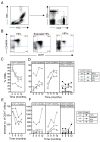Significantly skewed memory CD8+ T cell subsets in HIV-1 infected infants during the first year of life
- PMID: 18996749
- PMCID: PMC2722743
- DOI: 10.1016/j.clim.2008.09.006
Significantly skewed memory CD8+ T cell subsets in HIV-1 infected infants during the first year of life
Abstract
HIV-1 infection causes a severe T cell compromise; however, little is known about changes in naive, memory, effector and senescent T cell subsets during the first year of life. T cell subsets were studied over the first year of life in blood from 3 infant cohorts: untreated HIV-infected, HIV-exposed but uninfected, and HIV-unexposed. In HIV-infected infants, the frequency of CCR7(+)CD45RA(+) naive CD8(+) T cells was significantly decreased, while the frequency of CCR7(-)CD45RA(-) effector memory CD8(+) T cells was increased, compared with the control cohorts. A larger population of CD8(+) T cells in HIV-infected infants displayed a phenotype consistent with senescence. Differences in CD4(+) T cell subset frequencies were less pronounced, and no significant differences were observed between exposed and unexposed HIV-uninfected infants. We concluded that the proportion of naive, memory, effector and senescent CD8(+) T cells during the first year of life is significantly altered by HIV-1 infection.
Figures




Similar articles
-
Specific patterns of CD4-associated immunosenescence in vertically HIV-infected subjects.Clin Microbiol Infect. 2013 Jun;19(6):558-65. doi: 10.1111/j.1469-0691.2012.03934.x. Epub 2012 Jun 27. Clin Microbiol Infect. 2013. PMID: 22735071
-
Skewed maturation of memory HIV-specific CD8 T lymphocytes.Nature. 2001 Mar 1;410(6824):106-11. doi: 10.1038/35065118. Nature. 2001. PMID: 11242051
-
Partial recovery of senescence and differentiation disturbances in CD8+ T cell effector-memory cells in HIV-1 infection after initiation of anti-retroviral treatment.Clin Exp Immunol. 2016 Nov;186(2):227-238. doi: 10.1111/cei.12837. Epub 2016 Aug 23. Clin Exp Immunol. 2016. PMID: 27377704 Free PMC article.
-
Immunophenotyping of T cell subpopulations in HIV disease.Curr Protoc Immunol. 2005 Mar;Chapter 12:Unit 12.12. doi: 10.1002/0471142735.im1212s65. Curr Protoc Immunol. 2005. PMID: 18432939 Review.
-
Good cell, bad cell: flow cytometry reveals T-cell subsets important in HIV disease.Cytometry A. 2010 Jul;77(7):614-22. doi: 10.1002/cyto.a.20905. Cytometry A. 2010. PMID: 20583275 Free PMC article. Review.
Cited by
-
Biological Aging and Immune Senescence in Children with Perinatally Acquired HIV.J Immunol Res. 2020 May 16;2020:8041616. doi: 10.1155/2020/8041616. eCollection 2020. J Immunol Res. 2020. PMID: 32509884 Free PMC article. Review.
-
Immunogenicity of BCG in HIV-exposed and non-exposed infants following routine birth or delayed vaccination.Int J Tuberc Lung Dis. 2015 Apr;19(4):454-62. doi: 10.5588/ijtld.14.0608. Int J Tuberc Lung Dis. 2015. PMID: 25860002 Free PMC article. Clinical Trial.
-
The struggle of a good friend getting old: cellular senescence in viral responses and therapy.EMBO Rep. 2021 Apr 7;22(4):e52243. doi: 10.15252/embr.202052243. Epub 2021 Mar 18. EMBO Rep. 2021. PMID: 33734564 Free PMC article. Review.
-
Impact of elevated maternal HIV viral load at delivery on T-cell populations in HIV exposed uninfected infants in Mozambique.BMC Infect Dis. 2015 Feb 3;15:37. doi: 10.1186/s12879-015-0766-6. BMC Infect Dis. 2015. PMID: 25645120 Free PMC article.
-
Family adversity and autonomic reactivity association with immune changes in HIV-affected school children.Psychosom Med. 2013 Jul-Aug;75(6):557-65. doi: 10.1097/PSY.0b013e31829807fb. Epub 2013 Jun 13. Psychosom Med. 2013. PMID: 23766380 Free PMC article.
References
-
- Klenerman P, Hill A. T cells and viral persistence: lessons from diverse infections. Nat Immunol. 2005;6:873–9. - PubMed
-
- Sallusto F, Geginat J, Lanzavecchia A. Central memory and effector memory T cell subsets: function, generation, and maintenance. Annu Rev Immunol. 2004;22:745–63. - PubMed
-
- Seder RA, Ahmed R. Similarities and differences in CD4+ and CD8+ effector and memory T cell generation. Nat Immunol. 2003;4:835–42. - PubMed
-
- Masopust D, Vezys V, Marzo AL, Lefrancois L. Preferential localization of effector memory cells in nonlymphoid tissue. Science. 2001;291:2413–7. - PubMed
Publication types
MeSH terms
Grants and funding
LinkOut - more resources
Full Text Sources
Medical
Research Materials

